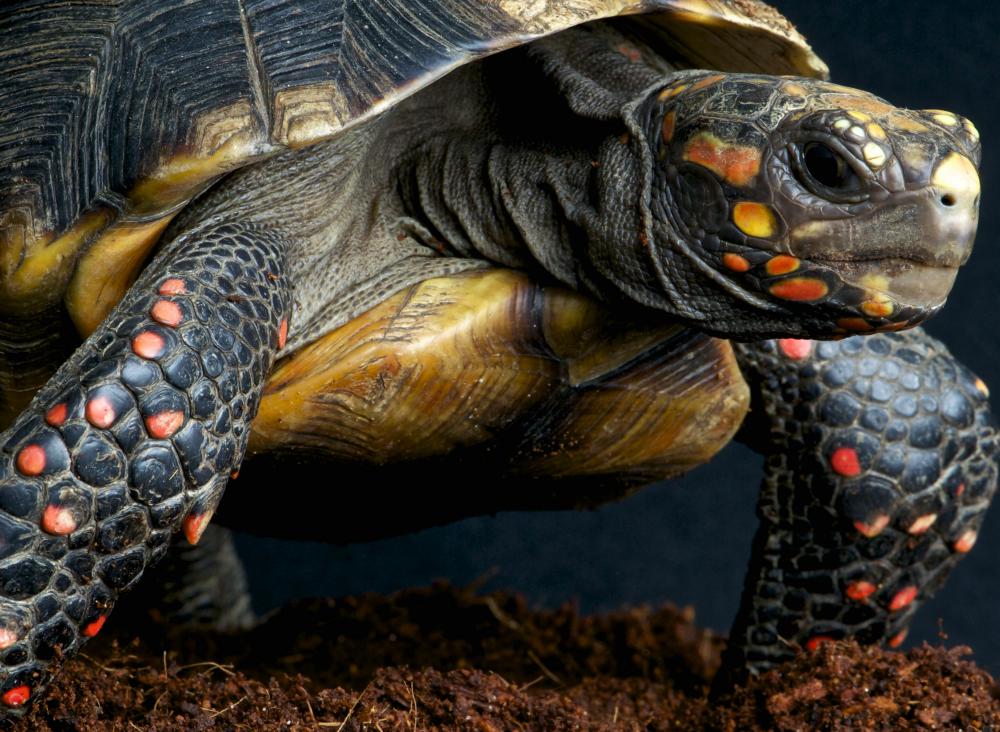At AllThingsNature, we're committed to delivering accurate, trustworthy information. Our expert-authored content is rigorously fact-checked and sourced from credible authorities. Discover how we uphold the highest standards in providing you with reliable knowledge.
What is the Russian Tortoise?
The Russian tortoise, also known as Horsfield's tortoise, is from the dry and arid desert regions of central Asia. Usually brown in color, the tortoise reaches up to 8 inches (20.32 cm) in length. They require a large amount of fiber in their diet and eat mostly leafy greens. Popular as a pet, the Russian tortoise is commonly bred in captivity and can live inside an appropriately sized enclosure. A healthy tortoise can live up to 50 years of age.
Fiber and calcium are the most important part of the turtle's diet. When kept as pets, calcium and vitamin D3 supplement powder should be sprinkled regularly on their food. Grains and fruit should never be given to a Russian tortoise. Instead, they should be provided daily with a fresh supply of leafy greens.

When living in the wild, the tortoises eat the majority of the food they consume in the summer months to prepare for winter hibernation. In captivity, however, a tortoise will eat a lot of food year round, resulting in improper growth if their diet is not monitored and restricted. As a result, the tortoise should not be allowed constant access to food.

Found primarily in Uzbekistan, the Russian tortoise also lives in Afghanistan, Iran, and Northwestern China. It prefers to live in rocky deserts, sandy hillsides, and dry steppes. As pets, the tortoises are regularly shipped from these areas to countries worldwide. If they are not captive-bred, they can have parasites and should be checked out immediately by a veterinarian after purchase.
The Russian tortoise can be easily bred in captivity. Mating season is in the spring and summer months following the hibernation period, starting in March. Hibernation begins in October for tortoises that live in the wild. Russian tortoises kept as pets may not hibernate at all, but will still only breed in the summer months.
Eggs are laid by a female tortoise 1 month after fertilization. In captivity the eggs are out laid out in the open, and in nature they are placed in a secure burrow. The male has nothing to do with the eggs or the female after fertilization. Female tortoises have no interaction with their offspring after laying her eggs. The eggs will hatch within 110 days, producing babies that are up to 1.34 inches (34 mm) in length.
A large wooden box full of enough soil to burrow in is an appropriate habitat for the Russian tortoise. When living indoors, a basking spot should be created for the tortoise using a 100 watt heat lamp that can reach temperatures of 90°F (32°C). A water bowl large enough for the tortoise to bathe in should be provided for hydration.
Frequently Asked Questions
What is a Russian Tortoise?
The Russian Tortoise, also known as the Horsfield's Tortoise or Agrionemys horsfieldii, is a small, land-dwelling reptile native to Central Asia. It is known for its hardy nature and ability to thrive in harsh climates, making it a popular choice among pet enthusiasts. These tortoises typically have a lifespan of 40 years or more when cared for properly.
What kind of habitat does the Russian Tortoise prefer?
Russian Tortoises are adapted to a dry, arid environment and are often found in sandy steppes, deserts, and scrublands in their natural habitat. They require a similar setup in captivity, with a basking area, temperature gradients, and low humidity to mimic their natural conditions and ensure their well-being.
What do Russian Tortoises eat?
Russian Tortoises are primarily herbivores, feeding on a variety of leafy greens, flowers, and weeds. In captivity, their diet should consist of calcium-rich greens such as dandelion, clover, and endive, supplemented occasionally with vegetables like carrots and squash. It's crucial to avoid overfeeding fruits, as these can upset their digestive system.
How large do Russian Tortoises get?
Russian Tortoises are relatively small compared to other tortoise species, with adults typically reaching sizes between 15-25 centimeters (6-10 inches) in length. Their size makes them manageable for most pet owners and suitable for living in indoor enclosures or outdoor gardens, provided the environment is secure and meets their needs.
How can I tell if a Russian Tortoise is healthy?
A healthy Russian Tortoise should have clear, bright eyes, a firm shell without any signs of damage or disease, and be active and alert. They should also have a good appetite and regular, solid bowel movements. Any deviation from these signs, such as lethargy or loss of appetite, may indicate health issues.
Are Russian Tortoises good pets for beginners?
Russian Tortoises can be good pets for beginners due to their hardy nature and relatively simple care requirements. However, potential owners should be prepared for a long-term commitment, as these tortoises can live for several decades. Proper research and preparation are essential to provide a suitable environment and diet for their well-being.
AS FEATURED ON:
AS FEATURED ON:












Discuss this Article
Post your comments